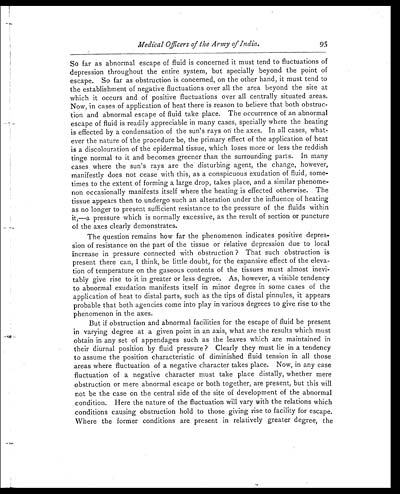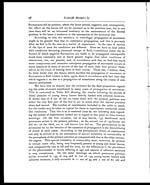Medicine - Institutions > Army health reports and medical documents > Scientific memoirs by medical officers of the Army of India > Part III, 1887 > 9 - On the phemonena of propagation of movement in Mimosa Pudica
(101) Page 95
Download files
Individual page:
Thumbnail gallery: Grid view | List view

Medical Officers of the Army of India.
95
So far as abnormal escape of fluid is concerned it must tend to fluctuations of
depression throughout the entire system, but specially beyond the point of
escape. So far as obstruction is concerned, on the other hand, it must tend to
the establishment of negative fluctuations over all the area beyond the site at
which it occurs and of positive fluctuations over all centrally situated areas.
Now, in cases of application of heat there is reason to believe that both obstruc-
tion and abnormal escape of fluid take place. The occurrence of an abnormal
escape of fluid is readily appreciable in many cases, specially where the heating
is effected by a condensation of the sun's rays on the axes. In all cases, what-
ever the nature of the procedure be, the primary effect of the application of heat
is a discolouration of the epidermal tissue, which loses more or less the reddish
tinge normal to it and becomes greener than the surrounding parts. In many
cases where the sun's rays are the disturbing agent, the change, however,
manifestly does not cease with this, as a conspicuous exudation of fluid, some-
times to the extent of forming a large drop, takes place, and a similar phenome-
non occasionally manifests itself where the heating is effected otherwise. The
tissue appears then to undergo such an alteration under the influence of heating
as no longer to present sufficient resistance to the pressure of the fluids within
it,—a pressure which is normally excessive, as the result of section or puncture
of the axes clearly demonstrates.
The question remains how far the phenomenon indicates positive depres-
sion of resistance on the part of the tissue or relative depression due to local
increase in pressure connected with obstruction ? That such obstruction is
present there can, I think, be little doubt, for the expansive effect of the eleva-
tion of temperature on the gaseous contents of the tissues must almost inevi-
tably give rise to it in greater or less degree. As, however, a visible tendency
to abnormal exudation manifests itself in minor degree in some cases of the
application of heat to distal parts, such as the tips of distal pinnules, it appears
probable that both agencies come into play in various degrees to give rise to the
phenomenon in the axes.
But if obstruction and abnormal facilities for the escape of fluid be present
in varying degree at a given point in an axis, what are the results which must
obtain in any set of appendages such as the leaves which are maintained in
their diurnal position by fluid pressure ? Clearly they must lie in a tendency
to assume the position characteristic of diminished fluid tension in all those
areas where fluctuation of a negative character takes place. Now, in any case
fluctuation of a negative character must take place distally, whether mere
obstruction or mere abnormal escape or both together, are present, but this will
not be the case on the central side of the site of development of the abnormal
condition. Here the nature of the fluctuation will vary with the relations which
conditions causing obstruction hold to those giving rise to facility for escape.
Where the former conditions are present in relatively greater degree, the
Set display mode to: Large image | Zoom image | Transcription
Images and transcriptions on this page, including medium image downloads, may be used under the Creative Commons Attribution 4.0 International Licence unless otherwise stated. ![]()
| Permanent URL | https://digital.nls.uk/75004309 |
|---|
| Shelfmark | IP/QB.10 |
|---|---|
| Additional NLS resources: | |




